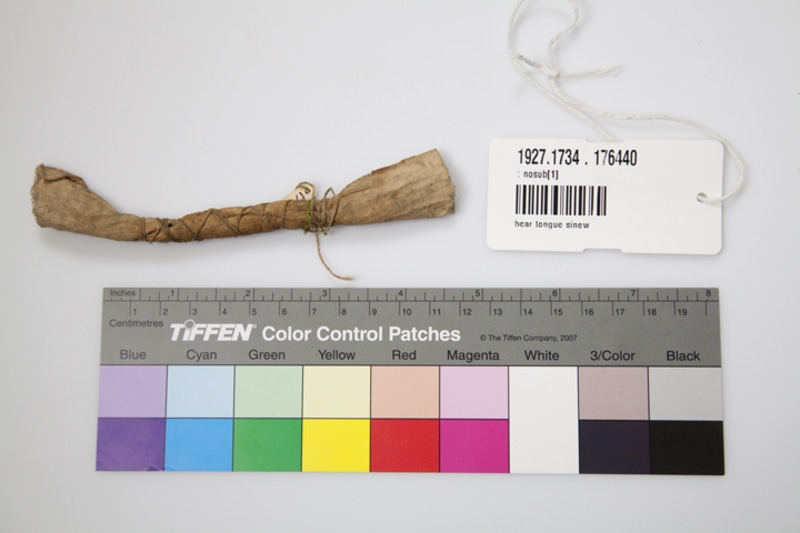bear tongue sinew Item Number: 1927.1734 . 176440 from the The Field Museum



Citations From Vanstone (1982) Article
« The consulting of oracles so as to determine where and when to hunt and to know the future with reference to the weather, illness, and personal matters was extremely important to the Lake St. John Montagnais. It is a subject that has been discussed in considerable detail by Speck (1935, pp. 138-147). A more recent discussion of the subject, with a different interpretation, is found in Tanner (1979, ch. 6). »
Vanstone, James W. "The Speck Collection of Montagnais Material Culture from the Lower St. Lawrence Drainage, Quebec." Fieldiana. Anthropology. New Series, No. 5 (October 29, 1982), p.19.
« Also associated with respect for a bear's spirit is the removal of an animal's tongue sinew which was taken from the carcass by the killer. To do so was believed not only to placate the bear's spirit, but to be a way of announcing the killing of the animal to the hunter's family without mentioning it by name. »
Vanstone, James W. "The Speck Collection of Montagnais Material Culture from the Lower St. Lawrence Drainage, Quebec." Fieldiana. Anthropology. New Series, No. 5 (October 29, 1982), p.20.
Translation Of Citations From Vanstone (1982) Article
« La consultation des oracles, qui servait à déterminer où et quand chasser et aussi à connaître le futur, notamment en ce qui a trait aux conditions météo, aux maladies et aux questions personnelles, était extrêmement importante pour les Montagnais du Lac-Saint-Jean. C’est un sujet qui a été discuté de façon très détaillée par Speck (1935, pp. 138-147). Une discussion plus récente sur ce sujet, comportant une interprétation différente, se retrouve dans Tanner (1979, ch. 6). »
Vanstone, James W. "The Speck Collection of Montagnais Material Culture from the Lower St. Lawrence Drainage, Quebec." Fieldiana. Anthropology. New Series, No. 5 (October 29, 1982), p.19.
« Aussi en signe de respect envers l’esprit de l’ours, on retrouve l’ablation d’un tendon de la langue d’un animal qui a été prélevé de la carcasse par celui qui l’a tué. C’était fait ainsi parce qu’on croyait que non seulement cela pacifiait l’esprit de l’ours, mais que c’était un moyen d’annoncer la mort de l’animal à la famille du chasseur sans avoir à le mentionner par son nom.
Vanstone, James W. "The Speck Collection of Montagnais Material Culture from the Lower St. Lawrence Drainage, Quebec." Fieldiana. Anthropology. New Series, No. 5 (October 29, 1982), p.20.
Item History
- Made in Pekuakami, Lac Saint-Jean, Lake St. John, Labrador, Canada
What
- Name
- bear tongue sinew
- Identification Number
- 1927.1734 . 176440
- Type of Item
- bear tongue sinew
- Material
- bear tongue sinew
Who
- Culture
- Ilnu, Montagnais and Innu
Where
- Holding Institution
- The Field Museum
- Made in
- Pekuakami, Lac Saint-Jean, Lake St. John, Labrador, Canada
Other
- Ethnic Group
- Montagnais
- Nom De L'objet
- Tendon de langue d'ours
- Matériaux
- tendon d'une langue d'ours
- Collection
- Lake St. John Objects
- Provenience
- North America, Canada, Quebec, Labrador, Lake St. John